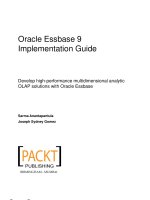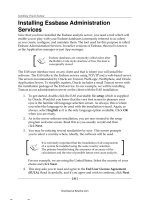Oracle Essbase 9 Implementation Guide- P17 potx
Bạn đang xem bản rút gọn của tài liệu. Xem và tải ngay bản đầy đủ của tài liệu tại đây (707.8 KB, 5 trang )
Chapter 3
[ 65 ]
The screenshot below shows the listing of the parent dimensions. The parent
dimensions can be considered the root dimension members as there are no higher
members in the hierarchical structure. The parent dimensions only have descendent
or children members. Look closely, the number in the braces, like the <4> indicates
the number of children under that dimension.
Take a look as we expand the TOTAL VEHICLE dimension. In the following
screenshot we see the TOTAL VEHICLE dimension expanded to reveal its
four child members:
Now you can clearly see the child members of the TOTAL VEHICLE dimension.
Notice how each child member has two of its own children as evidenced by the
<2> next to each member name.
In the following screenshot, you can see the TOTAL VEHICLE dimension
expanded completely:
This material is copyright and is licensed for the sole use by Paul Corcorran on 5th July 2009
8601 ave. p #1, , lubbock, , 79423
Download at Boykma.Com
Building the Essbase Outline
[ 66 ]
With the Total Vehicles dimension completely expanded, we see all of the child or
descendent members. We now know that we have reached the bottom level of the
dimension because there is no child indicator (<n>) next to the member names.
An Essbase outline dimension is the upper-most member in the
multidimensional hierarchical database structure. The dimension member
can have unlimited child members but has no parent member. The child
member can be a child member of the dimension parent and can also be
a parent or child to other members. Members, those of which are not at
the top level as dimension members, can have virtually unlimited child
members while at the same time being a child member themselves.
Outline members that share the same parent are called siblings. Essbase
is just one big happy family!
Outline member descriptors
Here, we have listed the Oracle Essbase database outline members' descriptors.
Please read this section carefully. Just about everything you do that pertains to
loading data, calculating data, and dimension building with data will depend
on your rm grasp of these key data relationship elements:
• Parent
• Child
• Siblings
• Ancestors
• Descendants
• Root
• Leaf
• Generation
• Level
Let's use the
Time dimension as the outline example used to help in describing
the denitions for these member descriptors. Please note that the Time dimension
contains the calendar periods used in the Esscar system.
This material is copyright and is licensed for the sole use by Paul Corcorran on 5th July 2009
8601 ave. p #1, , lubbock, , 79423
Download at Boykma.Com
Chapter 3
[ 67 ]
• Parent: A Parent is an outline member which has a child member or many
children members below it. For example: QUARTER 1 is a parent of JAN,
FEB, and MAR.
• Child: A Child outline member is an outline member that has a parent.
For example: JAN, FEB, and MAR are the children of QUARTER 1.
• Siblings: Sibling outline members are members that are at the same level
in the outline and share the same parent. For example: JAN, FEB, and MAR
are siblings.
• Descendants: Descendant outline members are all members below a parent,
which include any children and their children. For example: QUARTER 1,
QUARTER 2, JAN, and APR are the descendants of YEAR.
• Ancestors: Ancestor outline members are all members preceding a particular
member, including the parent, the parent's parent, and so on. For example,
QUARTER 1 and YEAR are ancestors of JAN.
• Root: The Root outline member is the top-most branch of a member tree.
For example, YEAR is the root member for QUARTER 1, QUARTER 2, JAN
and APR. All upper-most outline members are the root members of their
respective dimension. To put it another way, the root member has no parent.
• Leaf: Leaf is an outline member that has no children. The leaf member is also
called the
Level 0 member. For example: JAN, FEB, APR, and JUN are the
Leaf members or nodes or the lowest level member in its part of the outline.
This material is copyright and is licensed for the sole use by Paul Corcorran on 5th July 2009
8601 ave. p #1, , lubbock, , 79423
Download at Boykma.Com
Building the Essbase Outline
[ 68 ]
Generations and Levels
Although the previous member descriptor denitions are very important, you will nd
that as you gain more experience, the use of the generation and level descriptors are by
far the most commonly used and the most useful method of referring where a member
is in the database outline. This is true for loading, calculating, and retrieving data.
Generation
The term Generation refers to the location of a member in a dimension relative to the
root member. The upper-most generation is the outline itself which is
Generation 0.
Consider Generation 0 as the parent of the data dimensions. The root members are
the actual dimensions and are called
Generation 1.
The Generation approach to traversing your database outline is a
top-down approach. For example, Generation 1 is the highest
level or the root level and the Generation 2 would be the next
level down towards the leaf node or member which is the bottom
member of the dimension.
Just like a family tree, the next level down in the outline from the Year level
(the Quarter level) is Generation 2 in this example.
In the example below,
YEAR is Generation 1 (also called GEN 1), and Quarter 1,
Quarter 2, Quarter 3
and Quarter 4 are Generation 2 (GEN 2) whereas JAN,
FEB, MAR, APR
, and so on, are Generation 3.
GENERATION 1 Year
GENERATION 2 9 Quarter 1
GENERATION 3 9 JAN
GENERATION 3 9 FEB
GENERATION 3 9 MAR
GENERATION 2 9 QUARTER 2
GENERATION 3 9 APR
GENERATION 3 9 MAY
GENERATION 3 9 JUN
GENERATION 2 9 QUARTER 3
GENERATION 3 9 JUL
GENERATION 3 9 AUG
GENERATION 3 9 SEP
GENERATION 2 9 QUARTER 4
GENERATION 3 9 OCT
GENERATION 3 9 NOV
GENERATION 3 9 DEC
This material is copyright and is licensed for the sole use by Paul Corcorran on 5th July 2009
8601 ave. p #1, , lubbock, , 79423
Download at Boykma.Com
Chapter 3
[ 69 ]
Level
Level also refers to the location of a member in the outline dimension, but it's
counting starts from the leaf node all the way upto the root. The leaf node is called
Level 0, the parent of the leaf node is Level 1, and its parent is Level 2, and so
on until we reach the root member.
Looking at the example above, you can ask the question,
"In this outline, can the Quarter 4 member be considered
a Generation 2 member and a Level 1 member and can
the DEC member be considered a Generation 3 member
and a Level 0 member?" The answer is a resounding yes!
The Level approach to traversing your database outline
is a bottom-up approach. For example, the Level 0 is
the lowest level or the leaf node level. The Level 1 would
be the next level higher towards the root member.
In the example below, JAN, FEB, MAR, and APR are all Level 0. QUARTER 1, QUARTER
2
, QUARTER 3, QUARTER 4 are Level 1 members, and YEAR is a Level 2 member.
LEVEL 2 Years
LEVEL 1 9 Quarter 1
LEVEL 0 9 JAN
LEVEL 0 9 FEB
LEVEL 0 9 MAR
LEVEL 1 9 QUARTER 2
LEVEL 0 9 APR
LEVEL 0 9 MAY
LEVEL 0 9 JUN
LEVEL 1 9 QUARTER 3
LEVEL 0 9 JUL
LEVEL 0 9 AUG
LEVEL 0 9 SEP
LEVEL 1 9 QUARTER 4
LEVEL 0 9 OCT
LEVEL 0 9 NOV
LEVEL 0 9 DEC
This material is copyright and is licensed for the sole use by Paul Corcorran on 5th July 2009
8601 ave. p #1, , lubbock, , 79423
Download at Boykma.Com









